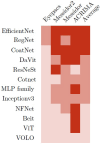A comparative evaluation of deep learning approaches for ophthalmology
- PMID: 39294275
- PMCID: PMC11410932
- DOI: 10.1038/s41598-024-72752-x
A comparative evaluation of deep learning approaches for ophthalmology
Abstract
There is a growing number of publicly available ophthalmic imaging datasets and open-source code for Machine Learning algorithms. This allows ophthalmic researchers and practitioners to independently perform various deep-learning tasks. With the advancement in artificial intelligence (AI) and in the field of imaging, the choice of the most appropriate AI architecture for different tasks will vary greatly. The best-performing AI-dataset combination will depend on the specific problem that needs to be solved and the type of data available. The article discusses different machine learning models and deep learning architectures currently used for various ophthalmic imaging modalities and for different machine learning tasks. It also proposes the most appropriate models based on accuracy and other important factors such as training time, the ability to deploy the model on clinical devices/smartphones, heatmaps that enhance the self-explanatory nature of classification decisions, and the ability to train/adapt on small image datasets to determine if further data collection is worthwhile. The article extensively reviews the existing state-of-the-art AI methods focused on useful machine-learning applications for ophthalmology. It estimates their performance and viability through training and evaluating architectures with different public and private image datasets of different modalities, such as full-color retinal images, OCT images, and 3D OCT scans. The article is expected to benefit the readers by enriching their knowledge of artificial intelligence applied to ophthalmology.
Keywords: Artificial intelligence; Deep learning; Diabetic retinopathy; Fundus imaging; Ophthalmoscopy.
© 2024. The Author(s).
Conflict of interest statement
The authors declare NO competing interests.
Figures








References
-
- Adam, B., & Kaveh, M. The rise of artificial intelligence in healthcare applications. In: Artificial Intelligence in healthcare 25–60 (Elsevier, 2020).
-
- Saria, S. Not all ai is created equal: Strategies for safe and effective adoption. NEJM Catal. Innov. Care Deliv.3(2), https://catalyst.nejm.org/doi/full/10.1056/CAT.22.0075 (2022). - DOI
-
- Decide-ai: New reporting guidelines to bridge the development-to-implementation gap in clinical artificial intelligence. Nat. Med.27(2), 186–187 (2021). - PubMed
-
- Food and Drug Administration and others, Proposed regulatory framework for modifications to artificial intelligence/machine learning (ai/ml)-based software as a medical device (samd) (2019).
Publication types
MeSH terms
LinkOut - more resources
Full Text Sources

